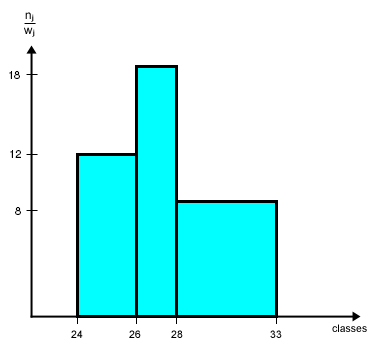Teaching:TUW - UE InfoVis WS 2007/08 - Gruppe 07 - Aufgabe 1 - Histogram: Difference between revisions
No edit summary |
No edit summary |
||
| Line 10: | Line 10: | ||
= Example = | = Example = | ||
As an example we consider values given from the table below to create a histogram (right image). The data derived from the first column of the table shows the class affiliation. According to the table values these classes are aligned along the x-axis of the histogram. Frequenzy values according to the classes are then printed along the y-axis of the histogram. Once this is properly done, the histogram shows the amount of | As an example we consider values given from the table below to create a histogram (right image). The data derived from the first column of the table shows the class affiliation. According to the table values these classes are aligned along the x-axis of the histogram. Frequenzy values according to the classes are then printed along the y-axis of the histogram. Once this is properly done, the histogram shows the amount of frequency according to any of the classes. Hence the histogram is a powerful visualisation that can make information accessable in just a few seconds, considering that the table on the left side is representing the same information, it is easy to understand the power of graphical visualisation. | ||
<table style="height:16px" border="0"> | <table style="height:16px" border="0"> | ||
Revision as of 14:06, 7 November 2007
Definitions
Explanation
TODO PETER ... WEBSTERs ...
Example
As an example we consider values given from the table below to create a histogram (right image). The data derived from the first column of the table shows the class affiliation. According to the table values these classes are aligned along the x-axis of the histogram. Frequenzy values according to the classes are then printed along the y-axis of the histogram. Once this is properly done, the histogram shows the amount of frequency according to any of the classes. Hence the histogram is a powerful visualisation that can make information accessable in just a few seconds, considering that the table on the left side is representing the same information, it is easy to understand the power of graphical visualisation.
Frequency Table
|
 |
||||||||||||
Frequency density (height of a column) = n j / w j
Related Links
References
- [Wikipedia, 2007] Wikipedia, Histogram. Retrieved at: November 01, 2007. http://en.wikipedia.org/wiki/Histogram
- [Wallgreen et al., 1996] Anders Wallgreen, Britt Wallgreen, Rolf Persson, Ulf Jorner and Jan-Aage Haaland. Graphing Statistics & Data: Creating Better Charts. SAGE Publications, Thousand Oaks, London, New Delhi, 1996.